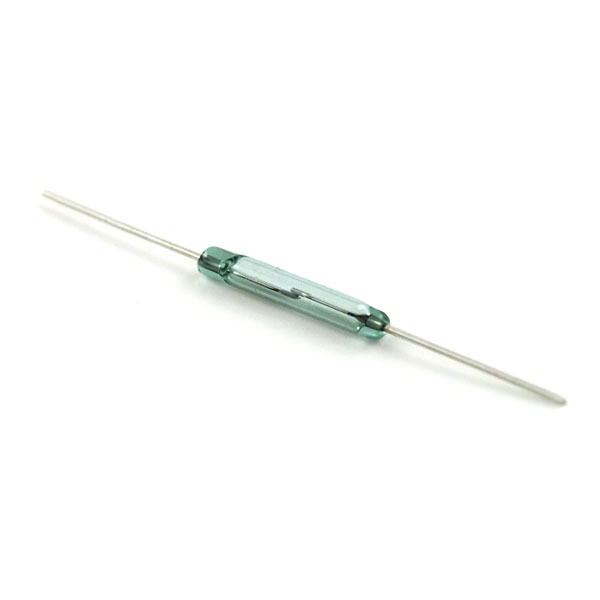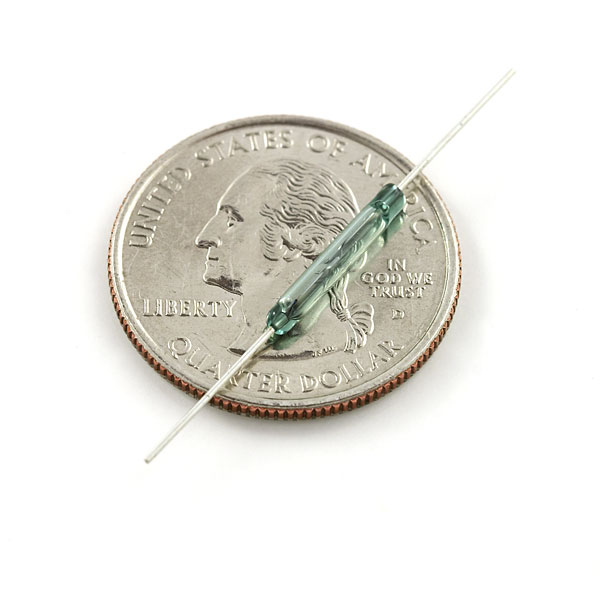This is a small device called a reed switch. When the device is exposed to a magnetic field, the two ferrous materials inside the switch pull together and the switch closes. When the magnetic field is removed, the reeds separate and the switch opens. This makes for a great non-contact switch. This switch can carry up to 1.2A.
Reed Switch Product Help and Resources
Button and Switch Basics
May 7, 2013
A tutorial on electronics' most overlooked and underappreciated component: the switch! Here we explain the difference between momentary and maintained switches and what all those acronyms (NO, NC, SPDT, SPST, ...) stand for.
Reed Switch Hookup Guide
May 5, 2016
Magnetically-actuated reed switches are the perfect component for non-contact proximity sensors. This tutorial provides a quick overview and example hook up.
Core Skill: Soldering
This skill defines how difficult the soldering is on a particular product. It might be a couple simple solder joints, or require special reflow tools.
Skill Level: Noob - Some basic soldering is required, but it is limited to a just a few pins, basic through-hole soldering, and couple (if any) polarized components. A basic soldering iron is all you should need.
See all skill levels
Core Skill: Electrical Prototyping
If it requires power, you need to know how much, what all the pins do, and how to hook it up. You may need to reference datasheets, schematics, and know the ins and outs of electronics.
Skill Level: Competent - You will be required to reference a datasheet or schematic to know how to use a component. Your knowledge of a datasheet will only require basic features like power requirements, pinouts, or communications type. Also, you may need a power supply that?s greater than 12V or more than 1A worth of current.
See all skill levels
Comments
Looking for answers to technical questions?
We welcome your comments and suggestions below. However, if you are looking for solutions to technical questions please see our Technical Assistance page.
Customer Reviews
2 out of 5
Based on 2 ratings:
1 of 2 found this helpful:
Get several, some don't work
I bought 5 of these and none of them worked all the time. Some did not wok at all, staying closed after the magnet was removed. Most worked some of the times. These will not work if the magnet does not stop at the switch. If the magnet goes by the switch without stopping. you get unreliable results.
Fragile
I'd have preferred plastic ones




For those asking about normally closed: use two magnets
Thanks for the help!
The datasheet is upside down.
Tested in Preview on Mac OS X, Foxit PDF and Adobe Reader on Windows XP, and xpdf on Debian.
Also, what it mean for this device to have a resonant frequency of 3.9kHz? That is significantly faster than the 1.25kHz frequency which would be indicated by the sum of the on-time (0.6ms) and off-time(0.2ms).
Or is your monitor just upside down? Just kidding. That's the only datasheet we got from them. Right click, rotate, it should work just fine.
Adding the on-time and off-time is not a suitable way to calculate resonant frequency. A switch in a resonant state is closing with both the magnetic force and the spring compression from the previous cycle, thus is accelerating slightly faster than a switch that was at rest before. When the switch is opening, it is also assisted by the spring compression from the previous cycle. I think that explains why resonant frequency is faster than merely adding on and off times. To illustrate by mechanical analogy: an SUV won't roll over if you swerve once, but if you swerve two or three times it might because each swerve builds up the potential energy on the springs as it bounces back and forth eventually building enough energy for the rollover. Of course, the closer the repeated swerves are to the roll mode resonant frequency of the suspension the greater the chances of roll over.
I want to turn a light on when a lid opens. Could I attach this to the wire, put a magnet on the lid, and have the lights off when the lid was closed?
i am making a chess board that will automatically record moves (and eventually store in pgn format) Will this type switch work for that application. I would mount the switch (64 of them, 8 x 8) under the board then, using magnetic chess pieces, the switch would activate when a piece is moved.
I need something small and low cost. that can fit in the size of a chess square and work through a small piece of wood or cardboard. a $5 switch would make for an expensive project.
This would work well for the application you are referring to. However, depending on what type of material you put over the piece, you may need an extremely strong magnet to trigger the reed switch. You may want to consider embedding the switch flush into each square so it can be more easily activated by the magnetic pieces.
ok, i will give them a shot.
i tried the hall effect sensors.
they worked but the latching is a problem. the reed switches seem like a simpler solution for what I am doing.
Stay away! The glass broke on both the ones I bought with just the slightest bending of the pins. First thing I've bought from Sparkfun that I would qualify as junk.
We're sorry about your poor experience. All reed switches are extremely fragile; if you need to bend the leads you MUST use a needle-nose pliers between the bend and the glass (but not touching the glass) to prevent ANY stress from being transmitted to the glass. Even better is not bending the leads at all. If you contact Customer Service (tell them I sent you) we'll see about getting you a replacement.
used this for a switch in my wall, LOVE neodenium.
These reed switches are horrible. I highly recommend anyone looking for one to stay far far away from these. First problem, the tube is very very brittle. If you don't bend the pins very carefully it will break rendering the switch useless. Second problem, I don't know how or why but the switch itself is for some reason is holding a charge after the magnet is removed. Simple test with arduino, have an led set to turn on when a digital pin is low, feed power through the reed switch to that pin. Add a magnet the led turns off immediately, remove the magnet there is a 15 or 20 second delay before the led turns back on. Remove the reed switch and just touch the power wire to the pin wire together and led turns off and on immediately. I even tried just putting power to the leg of the switch on the same side as the arduino pin to make sure the switch wasn't getting stuck closed and it still had the delay when the power was removed. You can add a pull down resistor on the pin side to correct this, but it's annoying having to use up another component for it. These things aren't worth 15 cent each, must less the 1.50 price.
https://www.sparkfun.com/products/10601
Small 5.0 x 2.2 x 1.8mm Normally Closed (N/C) reed switch: Here
where can i get a normally closed reed switch?
Normally-Closed, please?
kthxbye.
Well let me be the first to say, no joke, these things are fragile. If you try to bend the leads while holding the glass barrel, the glass will snap.
Also the leads are steel, and will attract the magnetic half of the switch. Design accordingly.
When installing one of these is it important to pay attention to orientation? If I put 2 orthogonal (90deg) to each other could I put them near each other and not have the fields interfere with each other?
Go to the manufactures web site. You will learn more that you want. These switch's have very tight tolerances. When you look you will be amassed.
How many cycles can be expected on avg?